
A number of studies have informed us about the substantial risk for HIV associated with chronic homelessness among youth in both the U.S. and Australia, even though these studies have typically been cross-sectional or samples of convenience. To understand the high seroprevalence rates among older homeless youth, the developmental trajectories into and out of risk for HIV and homelessness can best be understood from longitudinal studies of first time runaways, in which contextual factors (the national, community supports, street experiences, peers, and family) that influence these trajectories can be identified and observed over time.
The National Institute of Mental Health (NIMH) funds this study of new homeless young people. The purpose of the study is to understand the life course of new homeless youth and runaways. The study focuses on the many sources that are influencing youths pathways into and out of homelessness and risk for HIV, such as a youth’s family background, individual characteristics, personal resources, street experiences, peer social networks, interactions with social service providers, and informal support systems.
PROJECT i is following new homeless youth over time to see if they become more similar or dissimilar to experienced homeless youth. We know that among homeless youth, remaining homeless may only serve to increase their risk for HIV. This suggests a critical need to find ways to divert new homeless youth from the path of chronic homelessness and greater risk for HIV infection. The results of the study will be used to design interventions for new homeless youth to reduce their risk for HIV and to help inform service providers who may influence the life course of runaways and homeless youth and as a result help decrease their risk for HIV and becoming chronically homeless.
Approximately 240 youth, ages 12 to 20 years, are being recruited throughout various parts of Los Angeles County. A similar sample is being recruited in Melbourne, Australia. Youth who report having left home no more 180 days are eligible to participate in the study. An additional 200 youth per year, ages 12 to 20 years, who report having left the home for more than 180 days and who do not meet the above criteria, are eligible to participate in a one-time interview as part of a comparison group.
Following a baseline interview, study participants are interviewed at three months and then every six months for a total of eight interviews over a three-year period. Interviews take approximately one hour to complete. The baseline interview is conducted at the shelter or center where the youth was recruited. Follow-up interviews are conducted at a place convenient for the youth.
